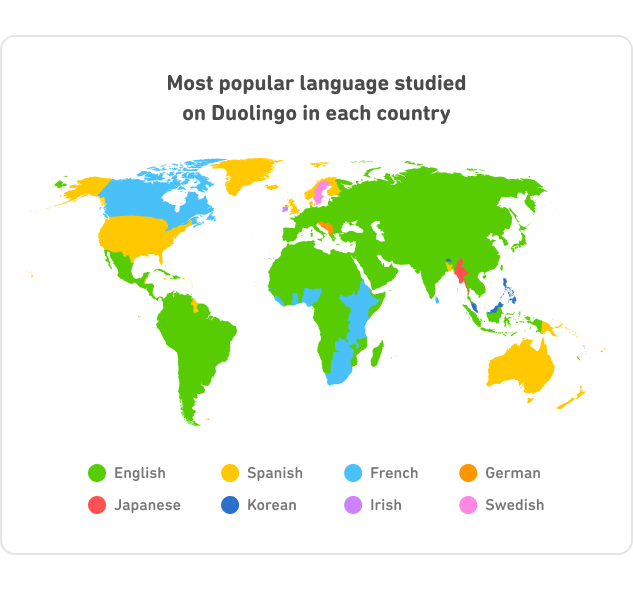The spring lockdown stage of the COVID-19 pandemic seems like years ago to a world that’s been shoved through several tragic, anxiety-inducing, hair-whitening phases of new surges and hotspots. But if you recall, in the Tiger King/stimulus check era of March and April, a top concern for a large swath of the world’s population was filling up and making productive their newly allotted ocean of homebound free time.
Many people took to learning new language skills, new data from Duolingo indicates.
During the spring COVID-19 lockdown, Pittsburgh-based language learning app saw an uptick in new user signups. From March 11 to April 30, Duolingo added 30 million new users worldwide, 67% more than the number of new users during the same period in 2019, according to a newly released company report. This timeframe spans from the day the World Health Organization declared COVID-19 a pandemic to the final month of the most severe government restrictions.
This lockdown spike pushed Duolingo past a milestone of 500 million total users since its launch in 2011. In April, Duolingo also surpassed one million paying users, who are willing to forfeit a monthly subscription fee to bypass ads and get a more optimized product.
Founded in 2009 by Carnegie Mellon University professor Luis von Ahn (now its CEO) and his graduate student-turned-CTO Severin Hacker, the company became Pittsburgh’s first unicorn last year, and it is perhaps the city’s only homegrown tech company familiar to the general public. That household name status is especially unique for a venture stemming from one of the city’s research institutes, which tend to spin-off companies involved in robotics and other advanced technology. A $35 million funding round in November saw the company valued at $2.4 million, and as of last year employed 166 people at its East Liberty headquarters, with plans to hire more. The pandemic accelerated a pattern of growth that puts Duolingo in a good position as it prepares an initial public offering expected in 2021.
Learning and lockdown
The annual report offers a look at the company’s global reach. It includes popularity trends of the 39 languages taught on Duolingo. Spanish advanced to second in the company’s self-calculated ranking of most-studied languages, supplanting French, and Asian languages saw rises in popularity.
The biggest takeaway: Like baking bread and home improvement projects, self-directed language learning helped fill voids and focus anxious minds during the pandemic.
The effect was seen at granular levels in the data, said Cindy Blanco, a Duolingo learning scientist and the author of the 2020 annual report.
Like baking bread and home improvement projects, self-directed language learning helped fill voids and focus anxious minds during the pandemic.
The company noticed a swell of new users in China on Feb. 20, the first day the country implemented massive restrictions on businesses and movement to mitigate the pandemic, said Blanco. March 9 was the start of the lockdown period in Italy, and also brought growth in Duolingo signups from that country. From then on, it was a trend in almost every country: When a lockdown began, new users spiked. And nations slower to take restrictive measures, like Canada and Brazil, had fewer Duolingo signups comparatively to nations that did.
There is no precise way to determine what is normal on Duolingo on new signups because its user base increases every year. But, typically, new signups increase in January with New Year’s resolutions, and again in late summer as students sign up for Duolingo Schools, its supplemental program for in-person classes. This year broke that mold with a lockdown spike — the increase in new users from March 11 to April 30 — that was 1.5x greater than its increase in users through the month of January, 2020, when the company picked up about 20 million more users than it did in December of 2019.
New user signups slinked down in May, but were still close to the impressive numbers of January. They have been slowly increasing since, perhaps because of a return of restrictions for public life and increased caution about gathering.
Anyone who has taken a few lessons on Duolingo knows the company is persistent in retaining users. Phone notifications featuring its green owl mascot plead with you to continue your streak of daily use. As for how long people who picked up French or Vietnamese during lockdown will keep up lessons, Blanco said it’s too early to say.
“I am curious to see how they act as a cohort,” she said.
One driver of new users is the Duolingo Schools programs. On March 18, new teacher signups for the program increased by 600%, compared to March 18, 2019, as teachers scrambled to move their lessons online after the mass closures of schools. During the lockdown period, 23% of new U.S.-based users said they were learning for school, compared to 17% for the same time period the previous year.
In any other year, the most significant news of Duolingo’s annual report would be that Spanish is the second-most popular language on the app. The metric Duolingo uses to rank the popularity of languages is a bit complicated. The number one language, English, is the most popular among active Duolingo users in the most countries. The number-two language is the one that is the second-most popular in the greatest number of countries. This was French and is now Spanish. The rest of the top ten, in order, is now German, Italian, Japanese, Korean, Portuguese, Russian and Chinese.

Duolingo’s offerings are all subcategorized as one-language-to-another lesson programs (French for English speakers, Hindi for Spanish speakers, etc.) and the company has not developed a course for each of its languages to match with every native speaker. Because of this and other factors, any ranking would be complicated and the company has decided on the above as the best representative of which languages are in-vogue.
In any case, the rise of Spanish is evident and predictable to Blanco. She said the leading factor is immigration from Latin American countries, particularly into the U.S., where Spanish is the most popular language on Duolingo.
“There are more people who speak Spanish everywhere, so the language takes on a lot of political and economic power,” she said.
However, people are not just learning Spanish to add it as a résumé skill. Sensing they were missing some motivators, in late 2019, Duolingo added “family” as an option when it asked new users why they were learning a language. Other options included school, travel, work, culture and brain training.
In 2020, 10.5% chose family as a motivator. “Maybe they want to connect with a family member or maybe they are dating someone or marrying into a family that speaks the language,” said Blanco.
Cultural influneces
Culture was a factor for 9.5% of new user signups in 2020, but Blanco thinks it may have an outsize role in the rotation of languages. The category can incorporate trends like the popularity of reggaeton or the increase in Spanish-language options on Netflix. Portuguese was particularly popular in South America in 2016, perhaps because Portuguese-speaking Brazil had hosted two globally important events recently, the 2014 World Cup and the 2016 Summer Olympics in Rio de Janeiro.
Cultural exportation may explain some of the fastest-growing languages on Duolingo, according to the report. Korean is the second-fasting growing language on Duolingo and the seventh-most popular overall.
“K-pop is popular everywhere,” said Blanco. “Korea has had a high-quality film industry for years, but people are most finding out about it.” Think Parasite’s Best Picture Oscar win.
Japanese is the third-fastest growing language and the sixth most popular overall. Meanwhile viewership of Japanese anime is on the rise on Netflix.
If you are glued to Attack on Titan or Castlevania on Netflix, perhaps COVID-19 provided the opportunity to take your interest in Japanese culture up a notch by signing up for lessons on Duolingo.
Going local
These COVID-era signups have been of tangible benefit to the company, said Sam Dalsimer, Duolingo’s head of public relations.
“It’s lead to an increase in our revenue base, which has grown every year,” Dalsimer said.
He said one of the company’s top goals is to increase use in Asian countries. Despite the global reach of the company and the transcontinental flavor of the app, it only has one foreign office, in Beijing. The company has had some blind spots as it has expanded into that hemisphere, said Dalsimer. The app once required an email address to open an account, but Chinese citizens rarely use email. Phone numbers and WeChat are much more common, so they allowed log-ins through those. They hope to learn more about how to make inroads in Asian countries.
Even with its expanding global reach, Dalsimer said that company will stay headquartered in Pittsburgh. Because of another effect of the pandemic, it should be easier to recruit to the city. The closing of nightlife and cultural institutions and the severity of COVID-19 in high-density cities has made smaller, inland cities for attractive to tech workers.
“People have been a lot more willing to relocate from places like Southern California,” he said.
Although Dalsimer declined to discuss details, he said Duolingo, which has steadily been raising cash from private investors, is still on track to become a publicly traded company in 2021.







